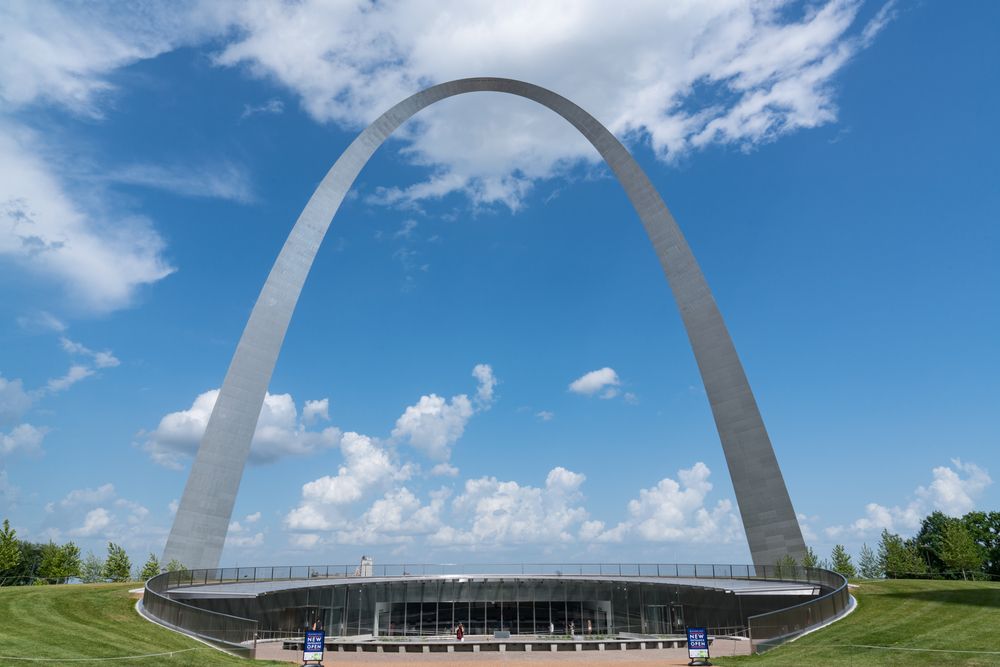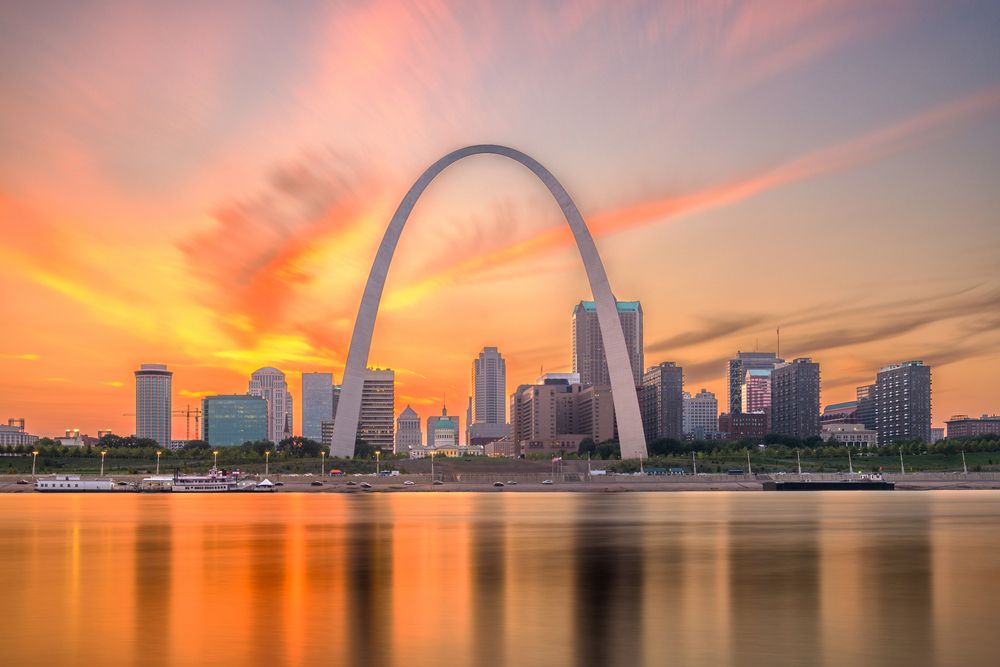Gateway Arch National Park
The Gateway Arch Visitor Center:

The St. Louis, Missouri Skyline:

Open / Close / Reopening Status of Gateway Arch National Park due to Coronavirus (COVID-19)
Last Updated: May 2, 2020
History of Gateway Arch
Jefferson Expansion National Memorial was designated as a memorial in 1935 by President Franklin D. Roosevelt. The location was pushed by Luther Ely Smith, who believed that the memorial for Jefferson should be in the Louisiana Purchase.
Eero Saarinen designed Gateway Arch. Saarinen was the winner of a national design competition in the 1940s with a first prize of $40,000. His plan was for the arch to use stainless steel on the inside and outside of the Arch. Saarinen is also known or designing Washington Dulles International Airport and the TWA Flight Center.
President Eisenhower signed the order to construct the Arch in 1954. Construction of the Arch began in 1963 and was completed in 1965. Forty blocks of St Louis were demolished to build the Arch and the surrounding park. The cost to build the Arch was approximately $13 million, which would be more than $100 million today when adjusted for inflation.
Gateway Arch honors Thomas Jefferson, who acquired most of the Western United States in the Louisiana purchase from the French government for $15 million in 1803. The land acquisition doubled the size of the United States, acquiring the land from the Mississippi to the Rocky Mountains from Canada to New Orleans.
Gateway Arch sits on the west bank of the Mississippi River, near the starting point of the Lewis and Clark Expedition. The first expedition to explore the lands west of the Mississippi River from the Louisiana Purchase began in 1804 after President Thomas Jefferson chose Meriwether Lewis for the job. The expedition concluded in 1806.
The Mississippi is the longest river in North America with a length of nearly 2350 miles. It begins in Lake Itasca in north central Minnesota and travels south until it drains into the Gulf of Mexico in Louisiana.
Frequently Asked Questions
Why is the Gateway Arch a National Park?
Gateway Arch is a 91 acre park that protects the Gateway to the West, an iconic symbol from the westward expansion of the United States in the 19th Century. It also contains
When did Gateway Arch become a National Park?
The Gateway Arch National Park Designation Act was adopted by Congress in 2018 and signed by the President on February 22, 2018. The St. Louis Gateway Arch Park, which had been a National Memorial since 1935, was dedicated as a national park on July 3, 2018.
Can you go up in the Gateway Arch?
Yes, you can go inside the Gateway Arch and up to the top. There is a tram ride to the Observation Deck of the Gateway Arch. The tour takes visitors up 630 feet to the top of America’s tallest human-made monument. The monument provides views to the east and west for up to 30 miles. The tram tour is not fully accessible to guests with impairments as wheelchairs, scooters and stollers are not permitted on the Observation Deck. There are also stairways in the St Louis Arch, but they are used by maintenance staff only.
How long does it take to visit the Gateway Arch?
The park includes the Gateway Arch, a museum, historic riverboats and the old courthouse where Dred Scott twice sued for his and his wife’s freedom, resulting in the famous Dred Scott decision by the U.S. Supreme Court. The tram tour takes approximately one hour so if your plan is just to do the Arch, you can plan for 2-3 hours. If you would like to tour the museum and the courthouse, or take a riverboat cruise, it will take more time.
Acadia National Park
American Samoa National Park
Arches National Park
Badlands National Park
Big Bend National Park
Biscayne National Park
Black Canyon National Park
Bryce Canyon National Park
Canyonlands National Park
Capitol Reef National Park
Carlsbad Caverns National Park
Channel Islands National Park
Congaree National Park
Crater Lake National Park
Cuyahoga Valley National Park
Death Valley National Park
Denali National Park
Dry Tortugas National Park
Everglades National Park
Gates of the Arctic National Park
Gateway Arch National Park
Glacier Bay National Park
Glacier National Park
Grand Canyon National Park
Grand Teton National Park
Great Basin National Park
Great Sand Dunes National Park
Great Smoky Mountains National Park
Guadalupe Mountains National Park
Haleakala National Park
Hot Springs National Park
Hawaii Volcanoes National Park
Hot Springs National Park
Indiana Dunes National Park
Isle Royale National Park
Joshua Tree National Park
Katmai National Park
Kenai Fjords National Park
Kings Canyon National Park
Kobuk Valley National Park
Lake Clark National Park
Lassen Volcanic National Park
Mammoth Cave National Park
Mesa Verde National Park
Mount Rainier National Park
North Cascades National Park
Olympic National Park
Petrified Forest National Park
Pinnacles National Park
Redwood National Park
Rocky Mountain National Park
Saguaro National Park
Sequoia National Park
Shenandoah National Park
Theodore Roosevelt National Park
Virgin Islands National Park
Voyageurs National Park
Wind Cave National Park
Wrangell-St. Elias National Park
Yellowstone National Park
Yosemite National Park
Zion National Park

